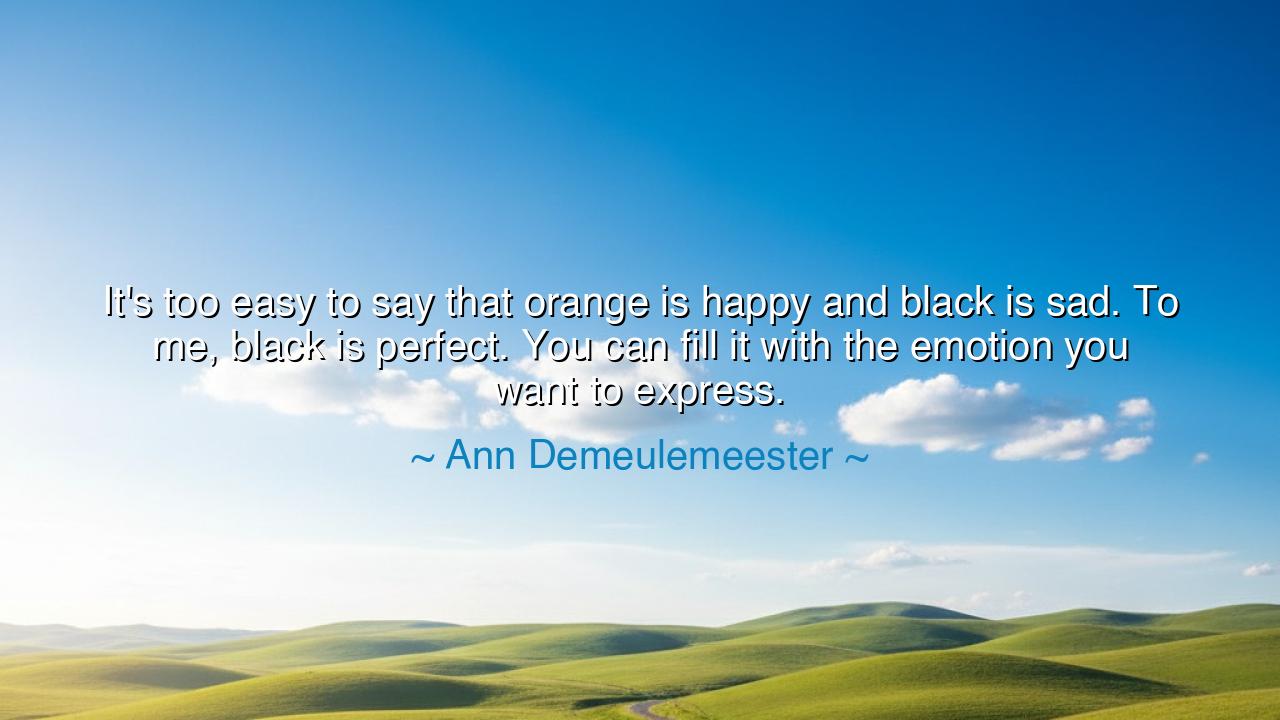
It's too easy to say that orange is happy and black is sad. To
It's too easy to say that orange is happy and black is sad. To me, black is perfect. You can fill it with the emotion you want to express.






Ann Demeulemeester, the Belgian designer whose work is often described as poetry stitched into fabric, once said: “It’s too easy to say that orange is happy and black is sad. To me, black is perfect. You can fill it with the emotion you want to express.” This reflection is not merely about color; it is about meaning, perception, and the human tendency to confine symbols into narrow boxes. She challenges us to see beyond convention, to look deeper into the essence of things, and to discover freedom in what others deem simple.
The world has long assigned colors to feelings. Yellow for joy, red for passion, blue for sorrow, and black for mourning. These associations carry the weight of centuries of tradition, yet Demeulemeester reminds us that such codes are not laws of nature but creations of culture. Black does not belong to grief alone—it is a canvas, infinite and open, waiting to be filled with whatever the heart pours into it. In her vision, it is not empty, but full of possibility.
Her insight mirrors the wisdom of the ancients. In ancient Greece, the philosopher Heraclitus taught that opposites contain each other, that what we call darkness may also carry within it light. Likewise, in Japan, the simplicity of black ink on white paper—seen in calligraphy and Zen painting—was never considered sad, but profound, complete, eternal. Across cultures, black has been a color of dignity, mystery, and even holiness, worn by monks and sages who sought to detach themselves from vanity.
The story of Rembrandt offers another echo of her words. In his paintings, black was not emptiness but depth. He used it to frame light, to give substance to the human face, to convey the full range of human emotion—sorrow, joy, tenderness, awe. Without black, his works would lose their force. So too with life: the presence of black does not diminish, but enriches, for it holds within it the contrast that makes meaning possible.
Demeulemeester’s declaration also speaks to the freedom of the artist. To say that orange is always happy and black always sad is to imprison creativity within narrow categories. But to see black as “perfect” is to reclaim the right of the artist to define, to assign, to play. It is to see the world not as dictated by tradition, but as alive, ever-changing, and capable of bearing new interpretations.
The lesson for us is profound: do not accept the world’s shallow symbols as final. Black is not sadness unless you place sadness into it; it can be strength, elegance, love, or eternity. The same is true of life’s circumstances—events themselves do not dictate meaning; it is we who paint them with emotion. To live fully is to recognize this freedom, to stop letting others define for us what is joyful, what is tragic, what is worthy of reverence.
Practically, this means questioning the assumptions handed down to us. Do not fear what the world calls dark. Instead, seek its richness, its depth, its hidden possibilities. Create your own associations; let your life be a canvas filled with your own meanings, not those imposed by convention. And when you encounter what seems empty or dark, remember Demeulemeester’s wisdom: you can fill it with what you choose.
Thus, her words are not merely about color but about life. They remind us that meaning is not fixed, but fluid. They call us to live as artists, painting our days not with borrowed codes but with the full truth of our own hearts. And in this way, even black—so often misunderstood—becomes not sorrow, but perfection.






AAdministratorAdministrator
Welcome, honored guests. Please leave a comment, we will respond soon